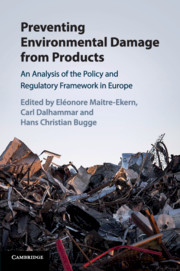 Preventing Environmental Damage from Products
Preventing Environmental Damage from Products Book contents
- Reviews
- Preventing Environmental Damage from Products
- Preventing Environmental Damage from Products
- Copyright page
- Dedication
- Contents
- Figures
- Tables
- Contributors
- Acknowledgements
- Abbreviations
- 1 Developing Legislation to Prevent Environmental Damage from Products
- Part I Structural Issues Associated with Regulating the Life Cycle of Products
- 2 Exploring the Spaceship Earth
- 3 Principles for the Design of a Policy Framework to Address Product Life Cycle Impacts
- 4 The Harm of Products and the Need of Information on Inputs, Production, Use and Disposal
- 5 Redefining Agency Theory to Internalize Environmental Product Externalities
- 6 Environmental Measures as an Obstacle to Free Movement of Goods in the Internal Market
- Part II Challenges Related to the Application of European Product Law
- Part III Conclusion by the Editors
- Index
2 - Exploring the Spaceship Earth
A Circular Economy for Products
from Part I - Structural Issues Associated with Regulating the Life Cycle of Products
Published online by Cambridge University Press: 21 April 2018
- Reviews
- Preventing Environmental Damage from Products
- Preventing Environmental Damage from Products
- Copyright page
- Dedication
- Contents
- Figures
- Tables
- Contributors
- Acknowledgements
- Abbreviations
- 1 Developing Legislation to Prevent Environmental Damage from Products
- Part I Structural Issues Associated with Regulating the Life Cycle of Products
- 2 Exploring the Spaceship Earth
- 3 Principles for the Design of a Policy Framework to Address Product Life Cycle Impacts
- 4 The Harm of Products and the Need of Information on Inputs, Production, Use and Disposal
- 5 Redefining Agency Theory to Internalize Environmental Product Externalities
- 6 Environmental Measures as an Obstacle to Free Movement of Goods in the Internal Market
- Part II Challenges Related to the Application of European Product Law
- Part III Conclusion by the Editors
- Index
Summary
Information
- Type
- Chapter
- Information
- Preventing Environmental Damage from ProductsAn Analysis of the Policy and Regulatory Framework in Europe, pp. 23 - 56Publisher: Cambridge University PressPrint publication year: 2018
Accessibility standard: Unknown
Why this information is here
This section outlines the accessibility features of this content - including support for screen readers, full keyboard navigation and high-contrast display options. This may not be relevant for you.Accessibility Information
- 1
- Cited by